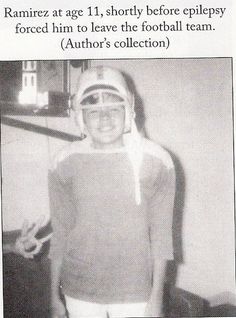From 1984 to 1985, 14 people were murdered and dozens more were terrorized in southern California. The offender was a viscous monster; he would quietly break into homes in the middle of the night, rape, torture, and sometimes kill his victims, then rob them of their belongings to feed his cocaine and heroin habit. The offender was ruthless. He was evil. He was remorseless. He was unstoppable… or so he thought. After 14 months of his reign of terror, 25 year old Richard Ramirez, now dubbed the ‘Night Stalker’, was captured. How did this young man become the psychopath he was? Contributing factors that may have led him to commit his crimes is the type of epilepsy he had, the negative influence that his cousin had on him, and his intense following of Satan.

Richard Ramirez did not have it easy growing up. The youngest of five children to Mexican immigrants, his family lived in poverty in El Paso, Texas. Both of his parents, Julian and Mercedes, worked multiple jobs to make ends meet. Mercedes worked long hours on an almost daily basis in a boot factory mixing pigments for the footwear. She worked with strong toxic chemicals such as xylene, benzene, and toluene. During this time, the high toxicity of these chemicals were not known. Due to her exposure to these strong chemicals, all of the Ramirez children were born with birth defects ranging from respiratory issues to Collier’s disease, a disease that causes bones to curve. Richard was diagnosed with Attention-Deficit and Hyperactivity Disorder (ADHD) as a young child. A study done on European children concluded that their exposure to chemicals while fetuses could have played a role in their diagnosis of ADHD (Forns et al.). Richard’s mother’s exposure to toxic chemicals at work could have contributed to his diagnosis of ADHD.
Due to his ADHD, he was a very active child who was often getting hurt. By the age of five, Richard had suffered from two incredibly severe head injuries. The first occurred when  he was two years old; as he tried to climb a dresser, it fell on top of him. The large gash on his forehead from the incident required 30 stitches. When he was five, a swing knocked him unconscious at a playground while he was playing with a sibling. Following that incident, he began suffering from epileptic seizures that subsided in his early teens. Specifically, he was diagnosed as having temporal lobe epilepsy. Temporal lobe epilepsy causes grand mal (convulsing) seizures where the person may experience hallucinations of voices, music, people, smells, or tastes (“Temporal Lobe Epilepsy”). According to Dr. Ronald Geshwind, those with temporal lobe epilepsy have “altered sexuality and hyper-religious feelings, are hyper graphic (have a compulsion to write), and are excessively aggressive” (Carlo, 1996). These traits may have carried on to adulthood and could have played a reason as to why he violently raped and murdered his victims. From the severity of how he mangled his victims, it shows how he would lose control of himself.
he was two years old; as he tried to climb a dresser, it fell on top of him. The large gash on his forehead from the incident required 30 stitches. When he was five, a swing knocked him unconscious at a playground while he was playing with a sibling. Following that incident, he began suffering from epileptic seizures that subsided in his early teens. Specifically, he was diagnosed as having temporal lobe epilepsy. Temporal lobe epilepsy causes grand mal (convulsing) seizures where the person may experience hallucinations of voices, music, people, smells, or tastes (“Temporal Lobe Epilepsy”). According to Dr. Ronald Geshwind, those with temporal lobe epilepsy have “altered sexuality and hyper-religious feelings, are hyper graphic (have a compulsion to write), and are excessively aggressive” (Carlo, 1996). These traits may have carried on to adulthood and could have played a reason as to why he violently raped and murdered his victims. From the severity of how he mangled his victims, it shows how he would lose control of himself.
Richard’s father had a short temper and was often physically and mentally abusive to him. He would also witness his father abuse his siblings and mother. He began to sleep at a local cemetery to escape his father’s aggressiveness. In a study done by Shawna Cleary and Joan Luxenberg, it was found that psychological and/or physical abuse was an

apparent characteristic in more than 60 serial killers. Adults who were abused during their childhood are three times more likely to act violently. In a different study conducted by James Beasley, among a group of 62 male serial killers, it was reported that 48% had been abused and/or rejected as children by a parent or other significant person in their life. This statistic proves how the effects of abuse continue through adulthood, and most likely through one’s entire life.
Richard found solace in his older cousin, Mike. When Richard was 12 years old, Mike returned from serving his second tour of duty as a Green Beret in the Vietnam War. They would spend time going on joy rides through El Paso, smoking marijuana together while Mike told Richard stories about his time in Vietnam. Richard was fascinated with Mike and his stories; he saw him as a hero, a male figure he could look up to. His father and his abuse was not filling that void. Mike would tell Richard about the abuse he inflicted on Vietnamese woman, showing him photographic evidence of the mutilations. He was

shown Polaroid’s of these terrified women performing fellatio on Mike as he looked to the camera and smiled. Other photographs showed decapitated heads, with one of them being one of the girls that was shown performing fellatio on Mike. Philip Carlo, a true crime novelist who wrote a detailed novel on the life of Richard, got to know Richard personally and was even shown the pictures. During a meeting with Philip, Richard told Philip something that Mike had told him. “Having power over life and death was a high, an incredible rush. It was godlike. You controlled who’d live and who’d died, you were God” (Carlo, 1996). These words stuck with Richard, and the graphic photographs he was shown sexually aroused him; he would masturbate to them. When he was 13, Richard witnessed Mike shoot his wife, Jessie, in the face after a brief argument. Richard was only a few feet away, and described the incident as being intense. “The line between life and death was right there in front of me. Intense. When she went down I saw it all in slow motion (Carlo, 1996). Witnessing the killing affected him; Mike was taken in to custody and now Richard could no longer spend time with the man he looked up to. However, Mike was a bad influence on Richard and could have inspired him to go out and kill for himself.
As time progressed, Richard became heavily interested in Satanism. After he was arrested for stealing a car, he met a long-haired blonde man with tattoos who was also a Satanist, and who could not stop talking about how great Satan was. He said Satan would protect and help anyone who was true to him. “You don’t ever have to feel guilty about anything. The only law is that you are true to your inner self. If you want to kill  somebody, that’s okay. What’s bad for them is good for us. Get it? ” (Carlo, 1996). After his release, Richard made it no secret that he followed Satan, drawing Pentagrams on his hands and arms. He did however, stay away from cults because he believed that they were compromised by police infiltration. According to Donna Louise Myers, a friend who he met while she was in El Paso on vacation, “He was very far into Satanism,” she added. “Satan was his friend, he said.” (Carlo, 1996). Richard was so deep into Satanism, he committed his crimes believing he would never be caught because Satan would protect him.
somebody, that’s okay. What’s bad for them is good for us. Get it? ” (Carlo, 1996). After his release, Richard made it no secret that he followed Satan, drawing Pentagrams on his hands and arms. He did however, stay away from cults because he believed that they were compromised by police infiltration. According to Donna Louise Myers, a friend who he met while she was in El Paso on vacation, “He was very far into Satanism,” she added. “Satan was his friend, he said.” (Carlo, 1996). Richard was so deep into Satanism, he committed his crimes believing he would never be caught because Satan would protect him.
Not everyone who grows up with a rough childhood is a psychopath, but the constant harshness in Richard’s childhood may have played a role as to why he ruined the lives of many in California during the years 1984 to 1985. He was a monster who connects to Thesis IV: The Monster Dwells at the Gates of Difference, of Jeremy Cohen’s Monster Theory. Richard went against what is morally okay; he brutalized dozens and took the lives of 14, all while having no remorse. The causal relationship in what may have lead Richard to commit his crimes are known as a Contributing Factors cause because they influenced the effect by increasing its probability. Though the families of those lives he took will never have a solid reason why Richard did what he did to their loved ones, a look into his childhood may give them some understanding.
Annotated Bibliography
Beasley, James O. “Serial Murder in America: Case Studies of Seven Offenders.” Behavioral Sciences & the Law, vol. 22, no. 3, 2004, pp. 395–414., doi:10.1002/bsl.595. This case study examines serial killers (seven in depth) and compares several characteristics they may entail. I used this source to emphasize the how many serial killers were abused as children. The abuse may have played a role in their violent behavior. This is a scholarly journal.
Carlo, Philip. The Night Stalker: The Life and Crimes of Richard Ramirez. Kensington Books, 1996. Philip Carlo is a true crime novelist who has closely examined the lives of multiple serial killers, including Richard Ramirez. Carlo personally interview Richard on multiple occasions, and was able to obtain accurate information on him. I used this source to cite quotes that Richard, a close friend, and a Doctor that studied Richard had said.
Cleary, Shawna, and Joan Luxenburg. Serial Murderers: Common Background Characteristics and Their Contribution to Causation. 1993. Cleary and Luxenburg conducted a study on more than 60 serial killers. Their goal was to see what characteristics may have contributed to these killers committing their acts. I used this source to state that childhood abuse is indeed a common characteristic in many serial killers.
Cohen, Jeffrey Jerome. Monster Theory: Reading Culture. University of Minnesota Press, 1997. Cohen wrote seven theses to determine different qualities that a monster may have. I used one of the theses to define Richard Ramirez as a monster. This is a scholarly source.
Forns, Joan, et al. “Prenatal and Postnatal Exposure to Persistent Organic Pollutants (POPs) and Attention-Deficit and Hyperactivity Disorder (ADHD): a Pooled Analysis of Seven European Birth Cohort Studies.” International Journal of Epidemiology, 17 Apr. 2018, doi:10.1093/ije/dyy052. Forns and company conducted a study on the prenatal and postnatal exposure to toxic chemicals, with an emphasis on Persistent Organic Pollutants, and how they can contribute to a person having ADHD. I used this source to provide evidence on how Richard’s mother’s exposure to toxic chemicals while pregnant with him may have contributed to his diagnosis of ADHD. This is a scholarly journal.
“Temporal Lobe Epilepsy (TLE).” Epilepsy Foundation, http://www.epilepsy.com/learn/types-epilepsy-syndromes/temporal-lobe-epilepsy-aka-tle. This web page defines temporal lobe epilepsy in detail, including the risk factors and symptoms. I used this source to define temporal lobe epilepsy. This website if provided by the National Epilepsy Foundation.
